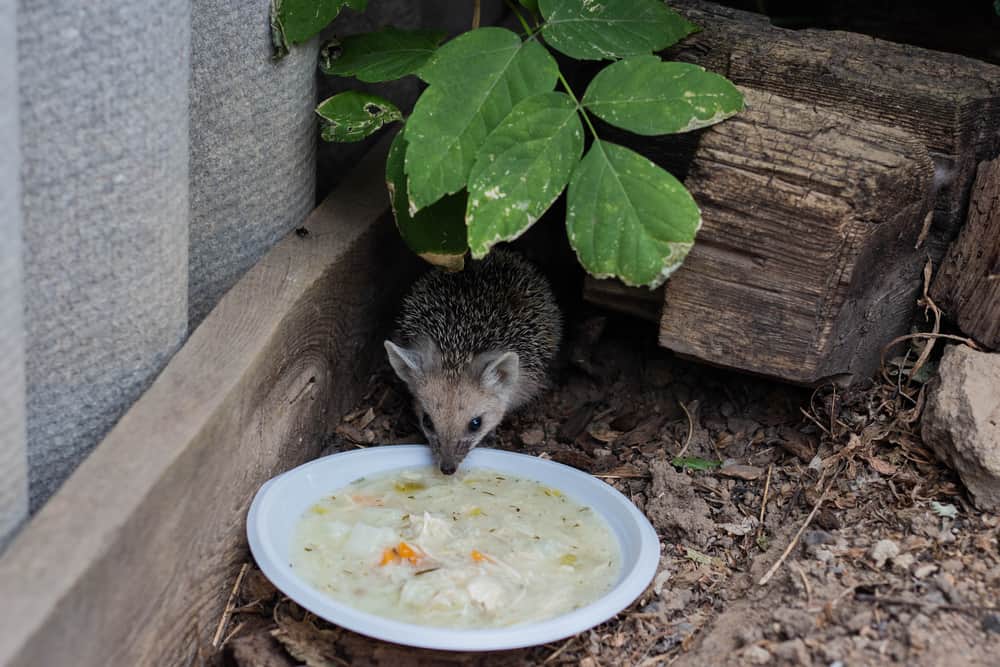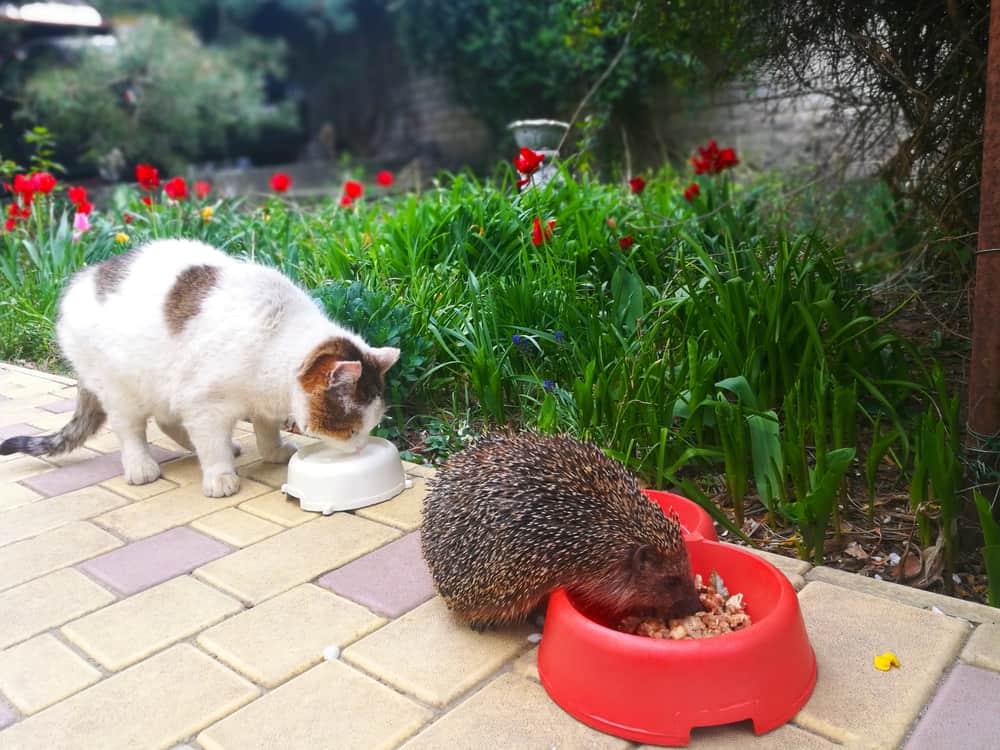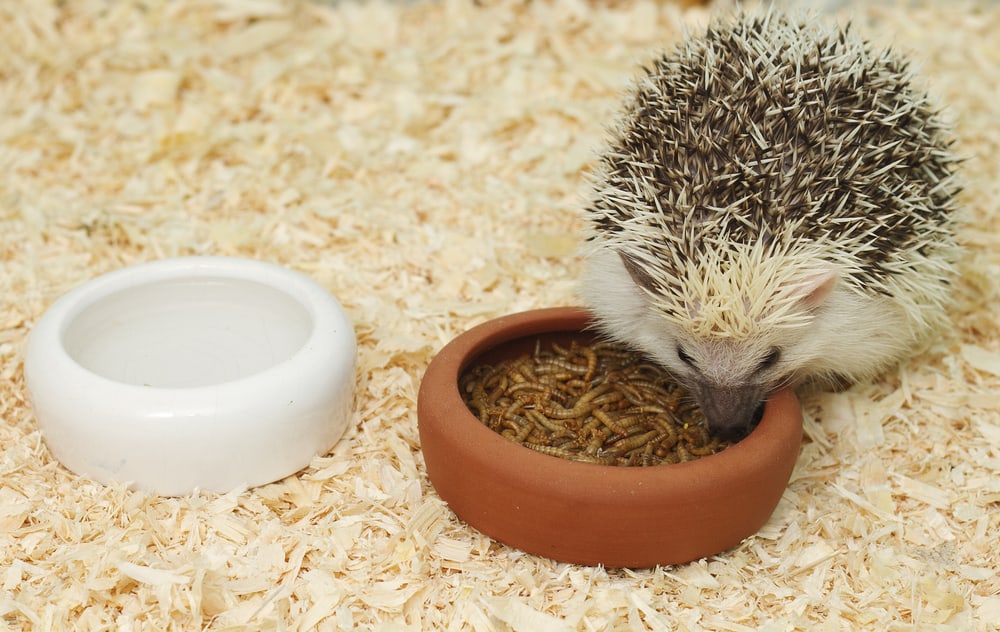The hedgehog (pincushion with legs) is a short and strong animal. Unlike other mammals that usually have a body covered by fur or hair, hedgehogs have modified hairs or quills, a thick layer of spikes that covers their back.
Even though many people believe that hedgehogs are insectivorous, these cuties belong to omnivorous. So, let’s see what do hedgehogs eat in reality.
Hedgehogs Habits and Biology
Hedgehogs are little warm-blooded animals with cone-shaped face lines, short legs, and bodies that hide below porcupine-like spikes. Even though porcupines and hedgehogs are similar, they are actually very different animals and not closely related. However, they share a similar appearance.
In contrast to porcupines, hedgehog spikes are not easy to segregate from their bodies. On average, each hedgehog has more than 6,000 spikes made of keratin on its body.
When it feels endangered, the hedgehog rolls into a ball. The goal is that the quills cover the whole space of its uncovered body and shields it from hunters. Once it forms a ball, it remains still. It is not true that hedgehogs can roll while forming a ball, but people widely believe it.
Hedgehogs are usually the perfect size to stand in an average human hand. They can grow approximately 4 to 12 inches (10 – 30.5 cm). Their weight usually depends on the species, but they can weigh 5 to 56 ounces (142 g – 1,6 kg) on average.
Hedgehog types |
|
| Scientific classification | Hedgehog |
| Kingdom | Animalia |
| Phylum | Chordata |
| Class | Mammalia |
| Order | Erinaceomorpha |
| Family | Erinaceidae |
| Subfamily | Erinaceinae |
| Genus | Erinaceus, Atelerix, Hemiechinus, Mesechinus, Parechinus |
There are 16 hedgehog species known, including the most represented:
- Southern African hedgehog (Atelerix frontalis)
- North African hedgehog (Atelerix algirus)
- Four-toed African pygmy hedgehog (Atelerix albiventris)
- European hedgehog (Erinaceus europaeus)
- White-breasted northern hedgehog (Erinaceus roumanicus)
- Long-eared hedgehog (Hemiechinus auritus)
- Desert hedgehog (Paraechinus aethiopicus)
These animals are common all around the world. You can find them in Europe, Asia, Africa, and New Zealand, living in various terrains, from savannas and deserts to forests and suburban gardens.
You can also find them living in burrows or nests that they build by themselves. Burrows are typically up to 20 inches (51 cm) deep and are made of leaves and other available vegetation. On the other hand, added branches make their nests firmer and more stable.
Hedgehogs can also make their nests somewhere between rocks that make their job easier. They can be very resourceful and even nestle somewhere where other animals lived before.
Do Hedgehogs Eat Dirt?
Hedgehogs live on the ground and primarily eat food from the ground. Therefore, it is not rare to eat dirt or sand by accident. However, they usually don’t prefer dirt because it is bad for their digestive system. If you have a hedgehog as a pet, you can sometimes notice that it eats sand added as a substrate in the cage.
Keep in mind that you are the one responsible for your unusual friend’s feeding. If you don’t do that properly, your hedgehog will probably eat sand because of the calcium deficit. The natural source of this mineral that every animal needs is sand, but be aware that consuming it can be fatal for your beloved pet.
What Do Hedgehogs Like to Eat Most?
Hedgehogs are omnivorous, and they can eat everything from insects to vegetables. They can also eat frogs, small reptiles, and bird eggs, but rarely. In most cases, this tiny creature will eat:
Earthworms
Hedgehogs hibernate from October to March, but they mainly eat earthworms while they are awake from April to October. They are the easiest prey for hedgehogs, and the chance that this prickly guy skips such a bite is minimal.
Scientists have proven that you can find around 200 earthworms per 11 sq ft (1 m2) of green surfaces. Worms that feed on the surface prefer hiding at edges, corners, and low vegetation. Hedgehogs look for them at those places, usually at night.
Insects
Hedgehogs’ nutrition plan puts insects at the top of the list. Those that live in the wild prefer eating:
- Wasps and bees
- Ants
- Grasshoppers
- Crickets
- Cockroaches
- Moths
They also enjoy eating earwigs and beetles from August to October, while they effortlessly find beetles from the order Coleoptera to eat from the beginning of April.
Insect larvae
Hedgehogs usually consume around 5.5 ounces (156 g) of invertebrates daily. That number includes a fair part of insect larvae without caterpillars.
In most cases, hedgehogs like eating leatherjackets, small Crane flies’ larvae. They are excellent food from September to the middle of October and again from April to May.
Caterpillars
Caterpillars make a part of hedgehog’s nutrition for four months in a year, particularly during the early spring and fall months. Hedgehogs never make a big difference between caterpillar species because they like them all, but the real treat for them is Comma Butterfly and Speckled Wood Butterfly’s larvae.
Gastropods
Gastropods like slugs and snails are a relatively small part of the hedgehog’s energy source, but they like to eat them sometimes. Wild hedgehogs slightly prefer eating slugs over snails.
They are pretty large, so hedgehogs eat them slowly, piece by piece. Unfortunately, slugs can be harmful to hedgehogs since they often carry fluke or lungworm parasites that cause respiratory illness.
Plants
Plants are not one of the primary food resources for hedgehogs, but they sometimes choose to eat fruits and vegetables that fall on the ground. They also like eating strawberries, apples, and cherries in different conditions.
It is pretty typical for these animals to eat plants only by accident. As a result, you can find a small amount of these plants in their internal organs and feces.
Food to Avoid Feeding Hedgehogs
Feeding a hedgehog is not hard at all because their diet is quite simple. Almost every insect you can find in an exotic pet shop will be good for your pet. However, you should avoid feeding it with insects caught outside since they can carry parasites and viruses. Many of them can be harmful, even deadly for your pet.
Additionally, avoid offering crushed peanuts and other nuts to your hedgehog. Those plants can get stuck in your pet’s mouth or throat and choke it. The same thing is with dried fruit that often causes choking.
I will also give you a list of other food your pet shouldn’t eat:
- Bread
- Raw meat and raw egg yolk
- Milk
- Spicy food
- Chocolate
- Citrus fruits
- Avocado and pineapple
- Grapes
- Onion
- Potatoes and celery
Remember that potato is a vegetable high in calories but low in nutrients, so it is better to avoid it. Plus, raw potatoes are usually toxic to some animals, including hedgehogs.
Hedgehogs are lactose intolerant, so giving them milk and dairy products will cause stomach illnesses followed by diarrhea. Some people believe that yogurt is acceptable for their pets since lactose proteins are different from those found in milk.
However, there is no scientific approval for such a decision. You can always test your pet to see its reaction to yogurt, but be careful with the amount offered.
Your hedgehog also shouldn’t eat grapes and raisins because they are toxic for these cuties. Finally, no one has a clue about how good or bad fish is for these prickly animals, but most experts are against giving fish to them. Therefore, it is better to avoid it.
It is necessary to be particularly careful if you let your pet walk around the house. If it intakes inadequate food by accident, you need to take it to the vet immediately.
Tips to Feed Hedgehogs
Hedgehogs are very resourceful in the wild, and they will indeed find everything they need. However, you need to know details about proper feeding if you have a hedgehog as a pet.
Food
Your pet should start getting enough food from the first day it gets out of hibernation. Be aware that hedgehogs need to prepare for this state, so providing enough food on time is crucial. That is the only way for them to build up fat reserves that they need to survive winter.
Treats
Your hedgehog doesn’t need any treats and will not ask for them. You can offer some fruits or vegetables to your pet from time to time, but avoid practicing it often. Always be aware that your hedgehog shouldn’t eat some fruit and veggie types at all.
Water
Your pet needs to have a constant water supply for 24 hours a day. There are many different ways to provide enough water, but most owners use sipper bottles installed in the cage.
It is crucial to check the water level often, particularly during dry and hot weather when your pet needs more fluids. Plus, be responsible and wash its water and food dishes often.
Summary
Feeding your lovely hedgehog won’t be too challenging, but sticking to the strict nutrition plan is necessary. You can always ask someone with lots of experience in this field to give you free advice. Additionally, you should be careful and dedicated to feeding your pet. Only that way, it will live a happy and prosperous life in your household.


